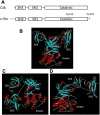Dissection of the catalytic and regulatory structure-function relationships of Csk protein tyrosine kinase
- PMID: 36936693
- PMCID: PMC10016382
- DOI: 10.3389/fcell.2023.1148352
Dissection of the catalytic and regulatory structure-function relationships of Csk protein tyrosine kinase
Abstract
Protein tyrosine kinases (PTKs) are a large enzyme family that regulates many cellular processes. The key to their broad role in signaling is their tunable substrate specificity and regulatory mechanisms that allow each to respond to appropriate regulatory signals and phosphorylate the correct physiological protein substrates. Thus, in addition to the general PTK catalytic platform, each PTK acquires unique structural motifs that confer a unique combination of catalytic and regulatory properties. Understanding the structural basis for these properties is essential for understanding and manipulating the PTK-based signaling networks in normal and cancer cells. C-terminal Src kinase (Csk) and its homolog, Csk-homologous kinase (Chk), phosphorylate Src family kinases on a C-terminal Tyr residue and negatively regulate their kinase activity. While this regulatory function is biologically essential, Csk and Chk have also been excellent model PTKs for dissecting the structural basis of PTK catalysis and regulation. In this article, we review the structure-function studies of Csk and Chk that shed light on the regulatory and catalytic mechanisms of protein tyrosine kinases in general.
Keywords: Csk and Chk; Src regulation; domain-domain interaction; kinase regulation; redox regulation; structure-function relationships; substrate recognition.
Copyright © 2023 Sun and Ayrapetov.
Conflict of interest statement
The authors declare that the research was conducted in the absence of any commercial or financial relationships that could be construed as a potential conflict of interest.
Figures




Similar articles
-
Csk-homologous kinase (Chk) is an efficient inhibitor of Src-family kinases but a poor catalyst of phosphorylation of their C-terminal regulatory tyrosine.Cell Commun Signal. 2017 Aug 7;15(1):29. doi: 10.1186/s12964-017-0186-x. Cell Commun Signal. 2017. PMID: 28784162 Free PMC article.
-
Structural elements and allosteric mechanisms governing regulation and catalysis of CSK-family kinases and their inhibition of Src-family kinases.Growth Factors. 2010 Oct;28(5):329-50. doi: 10.3109/08977194.2010.484424. Growth Factors. 2010. PMID: 20476842 Review.
-
Docking-based substrate recognition by the catalytic domain of a protein tyrosine kinase, C-terminal Src kinase (Csk).J Biol Chem. 2006 Mar 24;281(12):8183-9. doi: 10.1074/jbc.M508120200. Epub 2006 Jan 26. J Biol Chem. 2006. PMID: 16439366
-
Defining the substrate specificity determinants recognized by the active site of C-terminal Src kinase-homologous kinase (CHK) and identification of β-synuclein as a potential CHK physiological substrate.Biochemistry. 2011 Aug 9;50(31):6667-77. doi: 10.1021/bi2001938. Epub 2011 Jul 18. Biochemistry. 2011. PMID: 21699177 Free PMC article.
-
C-terminal Src kinase (CSK) and CSK-homologous kinase (CHK)--endogenous negative regulators of Src-family protein kinases.Growth Factors. 2005 Sep;23(3):233-44. doi: 10.1080/08977190500178877. Growth Factors. 2005. PMID: 16243715 Review.
Cited by
-
Regulation, targets and functions of CSK.Front Cell Dev Biol. 2023 Jun 16;11:1206539. doi: 10.3389/fcell.2023.1206539. eCollection 2023. Front Cell Dev Biol. 2023. PMID: 37397251 Free PMC article. Review.
-
Development of FRET Biosensor to Characterize CSK Subcellular Regulation.Biosensors (Basel). 2024 Apr 20;14(4):206. doi: 10.3390/bios14040206. Biosensors (Basel). 2024. PMID: 38667199 Free PMC article.
-
Non-Receptor Tyrosine Kinases: Their Structure and Mechanistic Role in Tumor Progression and Resistance.Cancers (Basel). 2024 Aug 2;16(15):2754. doi: 10.3390/cancers16152754. Cancers (Basel). 2024. PMID: 39123481 Free PMC article. Review.
-
Identification of oxidative phosphorylation-related genes in moyamoya disease by combining bulk RNA-sequencing analysis and machine learning.Front Genet. 2024 Jun 10;15:1417329. doi: 10.3389/fgene.2024.1417329. eCollection 2024. Front Genet. 2024. PMID: 38919950 Free PMC article.
References
-
- Advani G., Lim Y. C., Catimel B., Lio D. S. S., Ng N. L. Y., Chüeh A. C., et al. (2017). Csk-homologous kinase (Chk) is an efficient inhibitor of Src-family kinases but a poor catalyst of phosphorylation of their C-terminal regulatory tyrosine. Cell Commun. Signal 15 (1), 29. 10.1186/s12964-017-0186-x - DOI - PMC - PubMed
Publication types
Grants and funding
LinkOut - more resources
Full Text Sources
Research Materials
Miscellaneous

